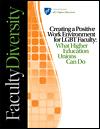LGBT Faculty
Over the past four decades, the nation has seen an explosion of lesbian, gay, bisexual and transgender (LGBT) activism, now touching nearly every college campus. Yet, far too many people still encounter discrimination based on their individual sexual identity, gender identity, and/or gender expression. The United State Constitution and subsequent laws like the Civil Rights Act of 1964 protect citizens from discrimination on the basis of race, ethnicity, and sex. LGBT individuals lack this protection and the void can leave them with no legal recourse to address the violation of their rights. Having the federal government explicitly extend full civil rights protections to LGBT people is paramount in the struggle for equality for this population.
The lack of civil rights protections also creates secondary problems in being able to collect data that would enable analysts to understand how pervasive the discrimination against LGBT people actually is. We do not have the information necessary to make claims about wages or issue of representation as the data sources we commonly use such as the Integrated Postsecondary Education Data System do not track sexual orientation and have no means of tracking transgender identity. Our own work on this issue has been forced to take a different tack than our work on racial and ethnic diversity and gender diversity in the faculty ranks: instead of focusing on issues of underrepresentation and economic discrimination we will instead be focusing on the campus climate for the LGBT population and how to improve it. We are indebted to organizations such as Campus Pride for resources such as the 2010 State of Higher Education for Lesbian, Gay, Bisexual & Transgender People, a survey conducted with more than 5,000 students, faculty and staff at colleges and universities in all 50 states, which let respondents identify their sexual identity, gender identity and gender expression in multiple ways.
The perceptions of campus climate for LGBT people at a particular institution can have an impact on LGBT students and faculty there. This population faces an array of challenges, ranging from personal attacks, both verbal and physical, to actions (intentional or otherwise) that isolate and alienate LGBT individuals, to institutional policies that prevent individuals from freely expressing their sexual identity and/or gender identity. Institutions can support LGBT students in a number of ways from creating clear institutional policies such as nondiscrimination policies and housing that accommodates LGBT people and supporting LGBT resource centers and student organizations.
As with students, the campus climate toward LGBT people can have a significant impact on how welcome LGBT faculty and staff feel on campus. Sixty percent of all faculty and 54 percent of all staff reported observing instances of LGBT harassment in their workplace. As with LGBT students, having well-defined university policies that are inclusive of LGBT concerns, and committing university resources and services to serving LGBT people, can help make for a positive campus climate for faculty and staff. Equitable access to benefits, particularly partner benefits, is a particularly significant issue.
We see the process of effectuating a diverse faculty and staff as an essential element in achieving a greater measure of economic and social justice in America. We recommend that each AFT higher education local make faculty diversity an important part of the union agenda on campus. This can be done by conducting an inventory to asses the condition of diversity on campus, discussing these conditions with leaders and members, and designating a group of people to coordinate the union's efforts in this area.
To learn more about what AFT recommendations for locals wishing to address gender diversity on their campus, read our report.

